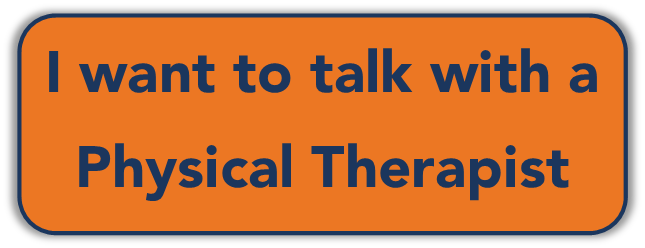
When you think about physical therapy for the treatment of pain or movement, you might wonder how long physical therapy will take. Often people think physical therapy is going to take months on end before they feel better. They think that physical therapy is this long drawn-out process. The reality is, the frequency and duration of physical therapy have a pretty broad range depending on your goals; for some conditions, physical therapy can last only a session or two, but recovery following a knee or hip surgery may last several months. The question you need to ask yourself is, “What do I want to achieve with physical therapy?” If you want to get the best recovery following surgery, reduce dizziness, or stop worrying about finding your next bathroom, you want to make sure that you are following the advice of your physical therapist and your physician precisely.
Physical therapists treat a variety of conditions ranging from traditional orthopedic concerns (like back pain and plantar fasciitis) to pelvic floor dysfunction (like incontinence and pelvic pain) to vestibular (like concussions, and vertigo or BPPV) and balance rehabilitation (for falls prevention). When you can answer what you hope to achieve with physical therapy, your PT will be able to give you a better idea of how long your physical therapy will last.
Let’s say that you want to relieve the back pain you suffer from, particularly while you sit at your desk at work. This is a common concern that we hear from our patients, they are stuck at their desks for long periods and life has made them less active than they would like. Your Physical Therapist is going to do an initial evaluation, she wants to know what is wrong with you and how you would feel if you were at your optimal functioning. Understanding your goals and your current level of functioning is going to help your physical therapist determine your plan of care. Your Plan of care is made up of your functioning goals and how long physical therapy will take to achieve those goals. Your goals are key because returning to optimal functioning and maintaining your gains is a 5-step process that begins with your evaluation:
- Evaluation
- Reduce and Eliminate Pain
- Improve Strength and Flexibility
- Optimize Functioning
- Maintaining Your Gains
(For More Information on the 5-Steps to Optimizing Function Through Physical Therapy)
Schedule a Free Consultation today.
If you only want to be out of pain, your physical therapist can likely get you there in a few sessions, but without addressing your strength and flexibility and without optimizing your functioning, reduced pain is transient. Your pain will be gone, but in a few months, you will be looking for another treatment. If you just spent a little more time with your physical therapist, if you spent a little more time improving your strength and flexibility and optimizing your body, you could alleviate your pain in the long term. Physical therapy is not a quick fix on the level of taking a pill, but it is much faster than recovery from surgery.
If you are coming for Benign Paroxysmal Positional Vertigo (BPPV), you can be back to normal in as little as one session. But if your physical therapist is a balance rehabilitation expert, she is going to check you for underlying balance insufficiencies. If you have any underlying deficits, you will need more than a single session with a couple of Epley Canalith Repositioning Maneuvers to get you to optimal functioning.
If you are looking for an answer about how long physical therapy will last, we have seen national averages across all diagnoses as low as 6 or 7 and as high as 12 to 14 sessions. Remember this is across a wide array of challenges, what you are facing may be more or less complex. Additionally, the focus of your physical therapists is going to vary, if they only want to get you out of pain, you will need fewer sessions, but if they are trying to get you optimal functioning, more sessions are going to be required once you are out of pain. Your commitment to your health and your home exercise program may also play into how long physical therapy will last for you and your condition.
Isn’t it time you called your Oklahoma City Physical Therapists to see what FYZICAL can do for you? CALL FYZICAL
How Many Times a Week Should You Go to Physical Therapy?
Some other factors will impact how long your physical therapy will last. One of those factors is the number of visits per week. Your physical therapist knows you are busy, they also know what it takes to meet your goals. They are not going to recommend physical therapy more often than is necessary to meet your goals, but they may factor in how often you can and will complete your home exercise program. Your PT knows that most people are not going to do their home exercise program as diligently as they should, but if she can get you into the clinic for a session more than once per week then she can supervise your exercise program and include modalities and manual therapy as is appropriate for your condition.
Generally speaking, your physical therapist will want to see you between 1 and 3 times per week. But knowing your goals and understanding your ability to commit to your plan of care is key in your physical therapist’s recommendation of how long physical therapy will last for you and how often you will need to be seen to meet that timeline. The number of sessions of physical therapy per week is dependent on a few different factors, including:
- How recently has the condition emerged? If you only recently injured your back, your physical therapist may want to see you 3 times per week to get you out of pain but may reduce that as you improve and are working on optimizing functioning. For a person with chronic pelvic pain and a supportive significant other, a single session per week may be all that is necessary because the process of reducing chronic pain is a longer process than optimizing functioning following a recent injury.
- Where are you in your course of treatment? At the beginning of your course of treatment, your PT will likely want to see you more often than at the end of your course treatment. You may optimize functioning and be doing exercises at home to maintain your gains, but your PT may set one last session for 2 weeks out just to check that you are performing everything properly and that you have truly made the gains you wanted when you set your goals for your plan of care during your initial evaluation.
- How are you progressing? If you progress quickly, you may need to reduce the frequency of visits each week rather than shortening how long your physical therapy will take. For example, when it comes to improving incontinence, for a woman who needs to build strength in the pelvic floor, this can take 8 weeks. If you are working consistently at home and making progress once a week may be enough, but if you are struggling to properly work the muscles of your pelvic floor, you may need to be seen more often so that biofeedback can be used and you can get the most of your home exercise program.
If more often is better, you might be wondering if more PT per session is also better.
You just need to get started with an evaluation, today!
How Long Does a Physical Therapy Session Last?
A session of physical therapy can vary in duration almost as much as the variation in how long physical therapy usually lasts. A session of physical therapy may be as little as 15 minutes (usually in intensive in-patient settings where a patient is getting daily if not multiple times per day physical therapy) to over an hour.
In the outpatient physical therapy setting, your session of physical therapy will generally last from 30-60 minutes, but longer is not always better. The quality and intensity of your physical therapy session can also vary. If you are spending your whole session with a licensed physical therapist or physical therapist assistant, you are getting a highly educated therapist who will be able to maximize your time and progress you through your treatment efficiently. If you are working sometimes with your PT or PTA and other times with a physical therapy tech, that tech maybe there just as a list-reader walking you through exercises without being able to progress you through any challenges or identifying areas you are struggling with.
Additionally, a lengthy physical therapy session may leave you sore like a good workout or a massage. When fatigue sets in you are not going to get more out of working longer, in fact, you may end up making things worse because your form is impacted. Your physical therapist is going to be able to identify that fatigue and move you to another activity (for example, ultrasound or manual therapy) that will get you the most out of your time at physical therapy.
How Long Does Physical Therapy Last?
By now you can understand that a lot goes into determining how long physical therapy usually lasts. The frequency and duration of your physical therapy are dependent on your needs and goals, but it can be an efficient and cost-effective solution for your pain. The question is straightforward, but because physical therapy is tailored to you because PT focuses on your needs rather than a cookie-cutter treatment, we need to know you. The easiest way to figure out how long physical therapy will last is to set your evaluation or a consultation with a physical therapist. At FYZICAL, we offer free screening and consultation so that we can understand your needs and help you determine the best course for your health.
-FYZICAL Therapy & Balance Centers of Oklahoma City
FYZICAL Therapy & Balance Centers of Oklahoma City provides orthopedic physical therapy in Lakeside, The Village, Nichols Hills, and surrounding NW Oklahoma City. Our physical therapists are specially trained to treat all types of pain, movement disorders, and musculoskeletal dysfunction including post-surgical recovery from ACL Tear. Our practitioners take a patient-centered individualized approach that focuses on your health needs. If you are unsure about your pain, or you want to see the FYZICAL Difference for yourself, schedule a free consultation today.


